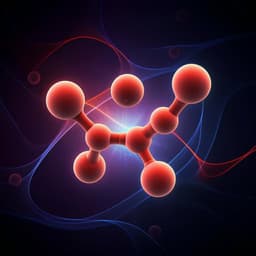
Physics
Signature of a randomness-driven spin-liquid state in a frustrated magnet
J. Khatua, M. Gomilšek, et al.
This fascinating research unveils the properties of the frustrated antiferromagnet Li₄CuTeO₆, revealing no long-range magnetic ordering even at ultra-low temperatures. Through innovative thermodynamic and muon spin relaxation measurements, the study highlights a disorder-driven, dynamic ground state resembling a random-singlets spin liquid, conducted by a talented team of researchers including J. Khatua and M. Gomilšek.
~3 min • Beginner • English
Introduction
The study addresses how quenched disorder and frustration influence quantum magnetism, particularly the emergence of quantum spin liquid (QSL) and random-singlet states in S=1/2 systems. Frustrated magnets suppress conventional symmetry-breaking and can host entangled, disordered ground states with fractionalized excitations. However, many experimental signatures deviate from ideal clean-lattice QSL predictions, and disorder often plays a decisive role. The authors investigate whether the frustrated antiferromagnet Li₄CuTeO₆ (LCTO), which possesses intrinsic Li/Cu anti-site disorder, realizes a randomness-driven spin-liquid-like ground state. They hypothesize that strong intrachain antiferromagnetic interactions with random defects and weak, frustrated interchain couplings produce a network of random singlets and a dynamic ground state without long-range ordering or spin freezing, leading to universal scaling in thermodynamic observables.
Literature Review
The paper situates its study within extensive work on QSLs and disorder-induced states. Canonical QSL candidates include triangular (κ-(ET)₂Cu₂(CN)₃, 1T-TaS₂), kagome (ZnCu(OH)Cl₂), and hyperkagome (PbCuTe₂O₅) systems. On honeycomb lattices, the Kitaev model predicts a QSL with Majorana excitations, inspiring exploration in A₂IrO₃ and α-RuCl₃, though many order at low T. Disorder has been implicated in suppressing order and inducing random-singlet physics in materials like YbMgGaO₄ (triangular, Mg/Ga site mixing), Sr₂CuTe₁₋ₓWₓO₆ (square lattice with W/Te substitution), H₃LiIr₂O₆, and α-Ru₁₋ₓIrₓCl₃. Randomness-induced dynamic states also appear in 3D systems such as Lu₂Mo₂O₅N₂ (pyrochlore). The random-singlet phase, originally observed in disordered spin chains (organic compounds; BaCu₂(Si₁₋ₓGeₓ)₂O₇), exhibits power-law thermodynamics (χ ~ T^{−γ}, C ~ T^{1−γ}) and field–temperature scaling collapse. Theory predicts broad applicability of randomness-induced QSL-like behavior in frustrated lattices. These precedents motivate searching for tunable-disorder 3d transition-metal systems like LCTO.
Methodology
- Crystal structure and diffraction: Phase purity checked by powder XRD; detailed Rietveld refinement of neutron diffraction at 300 K (λ = 1.28 Å) confirmed monoclinic C2/m with lattice parameters a=5.2752(5) Å, b=8.8163(8) Å, c=5.2457(5) Å, β=113.172(8)°. Mixed Li/Cu occupancies: Cu on 2d sites (p₂≈84%) and on defect 4g sites (p₃≈7%). Structural analysis identified two dominant exchange paths: (i) Cu₂–Cu₃ nearly-linear SE (Cu–O–Cu angle 173.3°, distance 4.12 Å) → strong AFM J′; (ii) Cu₂–Cu₂ super-superexchange (Cu–O···O–Cu via Te⁶⁺, O···O = 2.87 Å, Cu–O···O angle 138.6°) → strong AFM J. Other interchain interactions are expected to be ≲ a few kelvin.
- ESR: Powder ESR at 250 K, 256.3 GHz. Spectra fit with two uniaxial Lorentzian components; principal g values: dominant component g=2.06, 2.31; weaker component g=2.06, 2.20; intensity ratio ~85:15 consistent with p₂:2p₃.
- Ab initio DFT: LSDA+U on 2×1×2 supercell (U_eff = 9 eV) computed exchanges by fitting total energies of random spin configurations. With full Cu₂ occupancy, main-chain J_DFT ≈ 177 K; introducing one Cu₃ defect gave J′_DFT ≈ 824 K. All other exchanges < ~6 K.
- Exact diagonalization (ED): Thermodynamics of the high-T random 1D model (random-length Cu₂ chains with Cu₃ defects) computed by ED of many chain/defect configurations, probability-weighted to obtain χ_ED, C_mag,ED, and S_mag,ED vs T, field μ₀H, g, J, J′ for given p₂, p₃.
- Magnetization and susceptibility: DC χ(T) (1.9–300 K, μ₀H=1 T) fit to Curie–Weiss at high T to extract θ_CW and C; ED fits for T>20 K with constraints J/J′ ratio from DFT and p₂ fixed to neutron value; low-T ac susceptibility down to 45 mK at multiple frequencies to test for spin freezing; ZFC/FC in 100 Oe.
- Specific heat: C_p(T) from 0.052–250 K in fields up to 7 T. Lattice subtraction to obtain C_mag and S_mag; scaling analysis of C_mag with field per proposed random-singlet scaling C/T^γ = F(H/T^γ).
- μSR: ZF and longitudinal-field (LF=50 G) μSR to separate nuclear static and electronic dynamic fields via damped Gaussian Kubo–Toyabe model; TF-μSR at ~4900 G for Knight shift K vs T and K–χ scaling; analysis of relaxation rates λ (ZF/LF) and λ_γ (TF) vs T.
- Synthesis: Polycrystalline LCTO made by solid-state reaction; measurements performed on PPMS/SQUID platforms; neutron data collected at ILL; ESR measured at NHMFL. DFT with CASTEP; ED up to N=18 spins over >13,000 configurations.
Key Findings
- Structure and spin model: Monoclinic C2/m with Cu²⁺ predominantly on 2d sites (p₂≈84%) forming random-length chains along [101] with AFM J via Te-mediated SSE; a minority of Cu²⁺ on 4g (p₃≈7%) couples to two chain spins via strong AFM J′, introducing strong frustration. Other interchain couplings are weak (~≤6–10 K).
- ESR: Two uniaxial components with g≈(2.06, 2.31) and (2.06, 2.20); intensity ratio ~85:15 matches Cu site occupancies.
- DFT exchanges: J_DFT ≈ 177 K (Cu₂–Cu₂); J′_DFT ≈ 824 K (Cu₂–Cu₃); other exchanges < ~6 K.
- Susceptibility: No phase transition down to 1.9 K; Curie–Weiss fit (180–300 K): θ_CW = −154 K, C = 0.39 cm³ K mol⁻¹ → μ_eff ≈ 1.76 μ_B per Cu (S=1/2). ED-constrained fit (T>20 K) with p₂=84% yields g=2.28, J/J′=1.38, and (fit-sensitive) p₃=20% (neutron value p₃≈7% preferred). Extracted exchanges J ≈ 244 K and J′ ≈ 1140 K (noting overall scale depends on U_eff). Deviations below ~20 K indicate additional frustrated interchain couplings J_inter ≲ 10 K.
- Absence of freezing: No ZFC/FC splitting in 100 Oe; ac χ′ shows no peak or frequency dependence from 45 mK to 50 K → no spin-glass transition down to 45 mK.
- Scaling in magnetization: Data collapse of M·T^{−0.15} vs μ₀H/T from 2–50 K, consistent with random-singlet behavior.
- Low-T power laws: χ(T) ∝ T^{−γ} with γ = 0.82 ± 0.01 at low T; similar exponents reported in other random-singlet candidates.
- Specific heat: No anomaly down to 52 mK (zero field). With field, broad maxima shift to higher T due to Zeeman splitting of effective S=1/2 degrees of freedom from chain fragments/nominally isolated spins. C_mag/T exhibits T^{−0.5} at low T; integrated entropy from 0.052–2 K is ~13% of R ln 2, consistent with many spins locked in fragments (J, J′ ≫ T) and emergent frustrated 3D network via J_inter. Field–temperature scaling collapse of C_mag with exponent γ≈0.85: C_mag/(μ₀H)^{0.85}/T vs T/μ₀H collapses for multiple fields (2–7 T).
- μSR: ZF spectra lack oscillations and 1/3 tail; fits with damped Gaussian Kubo–Toyabe: nuclear field width ≈ 3.66 G; dynamic relaxation rate λ ≈ 0.023 μs⁻¹ and essentially T-independent down to 1.55 K, indicating persistent fast fluctuations and no static order. LF=50 G decouples nuclear contribution as expected. TF-μSR (≈4900 G): Knight shift K scales with bulk χ with two linear regimes, yielding coupling constants A ≈ −114 Oe μ⁻¹ (T<75 K) and A ≈ −211 Oe μ⁻¹ (T>75 K); K ∝ T^{−0.75} at low T, in line with χ(T). TF relaxation rate increases upon cooling with λ_γ ∝ T^{−0.2} at lowest T.
- Overall: No long-range order or spin freezing despite strong AFM interactions (θ_CW ≈ −154 K); multiple thermodynamic and local-probe signatures (power laws, scaling collapses) support a randomness-induced random-singlet, dynamic ground state in LCTO.
Discussion
The findings establish that intrinsic Li/Cu anti-site disorder in LCTO creates a frustrated network of random-length spin-chain fragments with strong AFM intrachain (J) and defect-mediated (J′) couplings, while weaker frustrated interchain exchanges J_inter couple fragment ground states into an emergent disordered ≥2D (likely 3D) network at low temperatures. This quenched disorder suppresses conventional long-range magnetic ordering and avoids spin-glass freezing, yielding a dynamic ground state with broad distributions of exchange energies characteristic of the random-singlet phase. The observed power-law behaviors in susceptibility (χ ∝ T^{−γ}, γ≈0.8) and specific heat (C_mag/T ∝ T^{−0.5}), together with field–temperature scaling collapses in both magnetization and C_mag (γ≈0.85), align with theoretical predictions for random-singlet systems. μSR confirms the absence of static internal electronic fields and reveals persistent fast spin dynamics down to T/|θ_CW| ≈ 0.01. Comparisons to other disordered frustrated magnets suggest that the absence of strong spin–orbit coupling in LCTO may yield larger scaling exponents than in 5d systems. The data indicate that interchain frustration, though subdominant in energy, dominates low-T physics by coupling effective S=1/2 fragment ground states, reinforcing a randomness-driven spin-liquid-like state.
Conclusion
We investigated Li₄CuTeO₆ using X-ray and neutron diffraction, magnetization, specific heat, ESR, and μSR, supported by ab initio DFT and ED. LCTO crystallizes in C2/m with Cu²⁺ forming random-length chains (J) along [101] and defect Cu²⁺ (Cu₃) sites coupling via strong J′ to neighboring chain spins, producing strong frustration. A large negative Curie–Weiss temperature (−154 K) indicates strong AFM interactions, consistent with DFT and ED fits at T>20 K. Low-T deviations highlight additional frustrated interchain couplings that govern the response below ~20 K. Thermodynamics show no long-range order down to 52 mK and no spin freezing down to 45 mK. μSR detects no static fields down to 1.55 K, evidencing a dynamic ground state. Magnetization and specific-heat data exhibit T/H scaling and data collapse, indicating a network of random singlets arising from anti-site disorder and weak frustrated 3D couplings. These results demonstrate a randomness-induced spin-liquid-like ground state in LCTO and motivate further studies of disorder-enabled quantum states and low-energy excitations in frustrated magnets.
Limitations
- The ED high-temperature random-chain model omits interchain couplings; low-T behavior (T≲20 K) deviates due to frustrated J_inter that are difficult to quantify and were found by DFT to be below ~6 K and thus unresolved.
- Absolute exchange scales (J, J′) depend on the chosen DFT U_eff; fitted p₃ from susceptibility is not robust because measurements probe T ≪ J′; neutron diffraction occupancies (p₂≈84%, p₃≈7%) are more reliable.
- μSR measurements were performed down to 1.55 K; while indicating persistent dynamics, they do not access the sub-100 mK regime where specific heat shows pronounced features.
- Polycrystalline samples were used; anisotropic properties and directional dependence of exchanges could not be probed directly as in single crystals.
- The precise form and distribution of interchain couplings and the impact of chain-fragment topology on random-singlet physics remain to be fully characterized; further theoretical and experimental work is needed.
Related Publications
Explore these studies to deepen your understanding of the subject.







